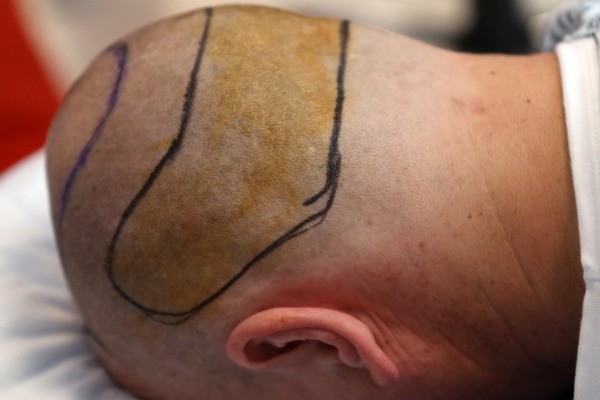
Procedure Time: Varies
Recovery Time: Varies
Cost: £2,300+
Anaesthesia: Local or a general anaesthesia
For a full list of FAQs please Click Here.
Scalp flaps have been used for treatment of male baldness since the early 1980’s. Patients who are only bald at the front of their heads are ideal candidates since recreating the hairline is the major aim of this procedure. Scalp Flap Surgery involves moving entire parts of the scalp, which is still growing hair into a bald area. Although it is the most dramatic approach to hair loss, it can often result in a thick hairline being immediately created somewhere else on the head after just one operation. This treatment is most effective in patients who have a receding hairline only, rather than a “horseshoe” shaped bald area on the top of their heads. Private prices for Scalp Flap Surgery vary depending on the individual case, although you would normally be looking at paying well over £2,300 for a straightforward procedure.
Do you have a question? Ask one of our experts NOWA local or a general anaesthetic is used before this procedure. The classic operation, known as the Juri flap, involves taking a very long and narrow strip of hair - bearing (donor) scalp from the temple to the back of the head. It is then turned round through approximately 90 degrees and placed in its new site at the hairline.
Different kinds of this procedure can now be carried out, including the scalp lift, which is very useful for treating hair loss on the top of the head. Scalp flap procedures can also be combined with a scalp expansion or extension (described above) to help remove excess bald skin prior to this operation.
Scalp flap procedures can also be successfully combined with hair transplantation to achieve a natural looking head of hair in a patient.
It is highly unlikely that anyone considering scalp flap surgery would be able to access this free of charge on the National Health Service.
However certain regions do make special cases, and we would always recommend that you visit your General Practitioner before embarking upon a cosmetic procedure involving surgery.
As well as their advice and guidance they may also be able to refer you to a local NHS Hospital who can treat you.
The NHS has set out the following guidelines on how to get cosmetic surgery through the NHS:
"To qualify for surgery on the NHS you must meet specific criteria as set out by your local health authority. The NHS will not pay for surgery for cosmetic reasons alone. Reconstructive and cosmetic surgery to correct, or improve, congenital abnormalities and injuries will usually be carried out free of charge.
NHS reconstructive surgery is performed by plastic surgeons who have had extensive training and belong to the British Association of Plastic Reconstructive and Aesthetic Surgeons. Surgeons who carry out cosmetic surgery through the NHS also belong to the British Association of Aesthetic Plastic Surgeons.
To receive cosmetic surgery from the NHS, you will normally need a referral from your GP. You will have a consultation with a plastic surgeon and an assessment by a psychiatrist, or psychologist. It will then be decided whether there is enough social, psychological, or physical benefit to be gained to justify surgery."
Private prices for Scalp Flap Surgery vary depending on the individual case, although you would normally be looking at paying well over £2,300 for a straightforward procedure.